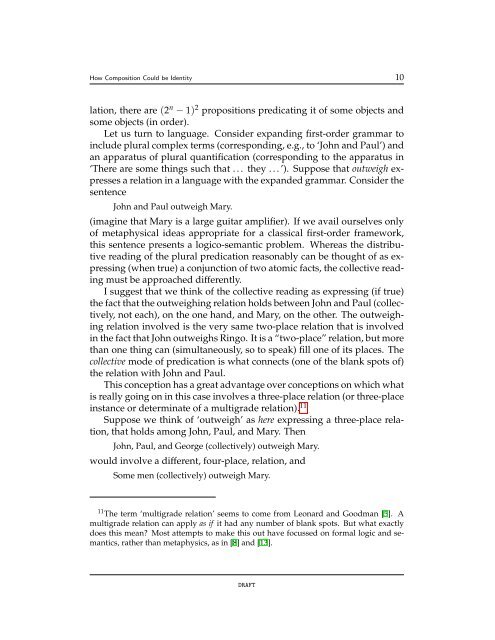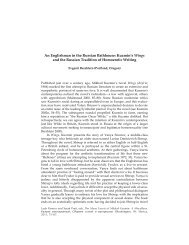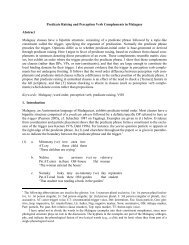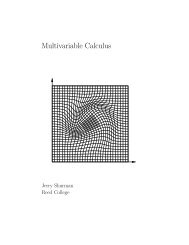How Composition Could be Identity
How Composition Could be Identity
How Composition Could be Identity
Create successful ePaper yourself
Turn your PDF publications into a flip-book with our unique Google optimized e-Paper software.
<strong>How</strong> <strong>Composition</strong> <strong>Could</strong> <strong>be</strong> <strong>Identity</strong> 10<br />
lation, there are (2 n − 1) 2 propositions predicating it of some objects and<br />
some objects (in order).<br />
Let us turn to language. Consider expanding first-order grammar to<br />
include plural complex terms (corresponding, e.g., to ‘John and Paul’) and<br />
an apparatus of plural quantification (corresponding to the apparatus in<br />
‘There are some things such that . . . they . . . ’). Suppose that outweigh expresses<br />
a relation in a language with the expanded grammar. Consider the<br />
sentence<br />
John and Paul outweigh Mary.<br />
(imagine that Mary is a large guitar amplifier). If we avail ourselves only<br />
of metaphysical ideas appropriate for a classical first-order framework,<br />
this sentence presents a logico-semantic problem. Whereas the distributive<br />
reading of the plural predication reasonably can <strong>be</strong> thought of as expressing<br />
(when true) a conjunction of two atomic facts, the collective reading<br />
must <strong>be</strong> approached differently.<br />
I suggest that we think of the collective reading as expressing (if true)<br />
the fact that the outweighing relation holds <strong>be</strong>tween John and Paul (collectively,<br />
not each), on the one hand, and Mary, on the other. The outweighing<br />
relation involved is the very same two-place relation that is involved<br />
in the fact that John outweighs Ringo. It is a “two-place” relation, but more<br />
than one thing can (simultaneously, so to speak) fill one of its places. The<br />
collective mode of predication is what connects (one of the blank spots of)<br />
the relation with John and Paul.<br />
This conception has a great advantage over conceptions on which what<br />
is really going on in this case involves a three-place relation (or three-place<br />
instance or determinate of a multigrade relation). 11<br />
Suppose we think of ‘outweigh’ as here expressing a three-place relation,<br />
that holds among John, Paul, and Mary. Then<br />
John, Paul, and George (collectively) outweigh Mary.<br />
would involve a different, four-place, relation, and<br />
Some men (collectively) outweigh Mary.<br />
11 The term ‘multigrade relation’ seems to come from Leonard and Goodman [5]. A<br />
multigrade relation can apply as if it had any num<strong>be</strong>r of blank spots. But what exactly<br />
does this mean? Most attempts to make this out have focussed on formal logic and semantics,<br />
rather than metaphysics, as in [8] and [13].<br />
DRAFT






